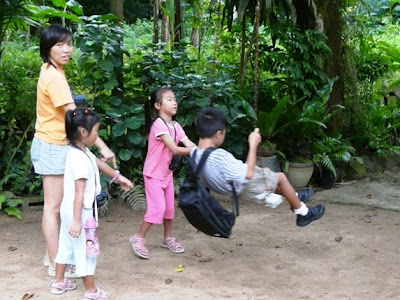& Benjamin Ho of The Nature Ramblers
Photos by Lena Chow and Timothy Pwee
A Sunday morning romp through the last surviving kampong (village) in mainland Singapore proved to be an irresistible proposition for some 40 kids together with their parents/caregivers. We crossed the bridge at Sungei Punggol (a canalized river) on 29 November 2009, and stepped gingerly onto the wide dirt track leading up to Kampong Buangkok, not quite knowing what to expect. Would this ‘kampong’ be a gimmicky and tacky village like so many of Singapore’s artificial attractions? Or would it be truly reminiscent of the kampong of yore: a somewhat messy cluster of wooden houses crowned with zinc roofs?

Uncle Ben calls the troops to order.
We were pleasantly surprised when Kampong Buangkok turned out to be a quaint little hamlet hidden in the midst of modernity, only a stone’s throw from buzzing Buangkok HDB estate and the private houses off Yio Chu Kang Road. Our little adventure was led by Uncle Ben of The Nature Ramblers, who was all geared up to transport the kids back in time, showing them how many of our forefathers lived before the advent of government flats.
 The courtyard swing had immediate takers.
The courtyard swing had immediate takers. According to Wikipedia, Kampong Buangkok was established in 1956 by Mr Sng Teow Koon, the father of Ms Sng Mui Hong, who continues to live here with her nieces while her three other siblings (who are co-owners) have longed moved out. Mr Sng started by renting out land for people to build homes. By the 1960s, Kampong Buangkok housed some 40 families, with residents paying just $2 to $3 in monthly rent. Its land area has since shrunk from 21,460 m2 to 12,248 m2. Today, the Kampong is home to 28 families (18 Chinese and 10 Malays), who are mostly elderly residents, workers and even a make-up artist. Rental is still kept at a nominal $13 and these folks continue to enjoy the slower pace of life typical of a kampong existence.
As Kampong Buangkok is in a low-lying area, it is still affected by flash floods, especially when heavy rains coincide with high tides. We were greeted by a signboard detailing the week’s high tides written in red ink, which stood prominently at the entrance along Lorong Buangkok. As our group wandered amongst the many fascinating facets of kampong life, the children played a game in which they had to act out parts depicting the buildings, plants, birds and insects encountered.
 What is a kampong without lush vegetation?
What is a kampong without lush vegetation? Kampong mongrels welcomed us with wagging tails. The kids were excited when they spotted a wooden coop, crowding around to look at the clucking chickens held within. Some parents were tempted to buy biscuits from a sparsely-stocked ‘provision shop’, but it turned out to be part of a movie set. Kids saw how kampong houses were built simply from wooden planks punctuated with ventilation holes, and painted in an assortment of colours, some as outlandish as pink. And yes, the houses were crowned with zinc roofs.
 Ms Sng Mui Hong, owner of Kampong Buangkok.
Ms Sng Mui Hong, owner of Kampong Buangkok. Dirt tracks linked the various homes, lined with fruit trees like coconut, rambutan and banana, and fragranced by the presence of pandan and lemon grass. The calls of caged merboks, bulbuls and mata putehs added to the relaxing soundscape. Most homes were ragtag spartan and suitably messy, some sporting outdoor kitchens with utensils strung out in rows. However one house, tucked in an obscure corner, was downright pretty, with a porch featuring Balinese-style wooden doors capped with charming metallic motifs, inviting teak furniture and other cosy decorations.
 The street sign here still uses the four-digit postal code!
The street sign here still uses the four-digit postal code!
Amongst the verdant vegetation, we found birds like the Black-naped Oriole, Asian Glossy Starling, Laced Woodpecker and Peaceful Dove. Aside from hearing the calls of cicadas, the kids were treated to sightings of butterflies, bees and grasshoppers. The walk concluded with a short trek along Sungei Punggol which runs alongside the Kampong, where we caught glimpses of the Blue-tailed Bee-eater and Collared Kingfisher.
 The street sign here still uses the four-digit postal code!
The street sign here still uses the four-digit postal code!